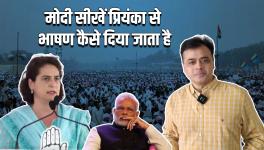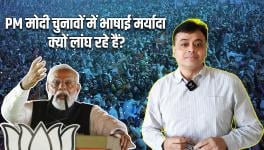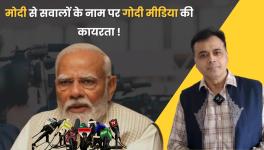Bihar: Unemployment, Price Rise Dominate, but Caste Factor Still Matters in Poll Campaigns

Patna: Though on the surface, the dominant issues among people are rozgar, berozgari, mehagai, garibi and vikas (employment, unemployment, price rise, poverty and development) in Bihar during the ongoing Lok Sabha election campaign, but in reality, caste is turning out to be as important an issue, if not more, for the ruling Bharatiya Janata Party-led National Democratic Alliance as well as the opposition Mahagathbandhan. Both the alliances are banking on caste factor.
The caste factor and caste equations remain a key deciding element for support and vote among people in rural and urban areas.
According to political watchers here, caste has always played a vital role in Bihar politics, though there are exception like 2019 Lok Sabha polls when hyper Hindu nationalism and Hindutva overshadowed the caste factor.
"It is accepted fact that caste equations play a major role in deciding candidates and their winnability factor. This is true for all parties", S N Madan, an analyst tld NewsClick.
Madan said that caste is a deciding factor for political parties in Bihar is clear from the fact that they have taken care to field candidates to suit the caste equation on the ground.
For instance, for BJP, the upper castes matter more than others. This is evident as the saffron party has played a calculated caste card in selecting candidates for the 2024 Lok Sabha polls. It has fielded 10 upper castes out its total17 candidates in the fray.
"We are confident of overwhelming support of upper castes in favour of BJP, there are no ifs and buts, "a senior BJP leader said.
In BJP's list of candidates, five belong to the Rajput caste, followed by two for the Bhumihar caste, two Brahmins and one from the Kayastha community.
The party has renominated most of its upper caste MPs, except Ashwani Kumar Choubey, who is a Union Minister. Choubey is a sitting MP from Buxar Lok Sabha seat and has been replaced by Mithilesh Tiwari, a young party MLA.
What has surprised poll-watchers is that BJP has not changed its old faces, contrary to reports that new faces will replace them. It has renominated Union ministers R K Singh from Ara, Griraj Singh from Begusarai and former Union ministers Rajeev Pratap Rudy from Saran, Ravi Shankar Prasad from Patna Sahib and Radha Mohan Singh from East Champaran.
In the caste-ridden politics of the state, since the early 1990s, the BJP has been heavily relying on its upper caste vote bank and has emerged as a significant party in Bihar that claims to safeguard their interests.
Political watchers say that upper castes have been overwhelmingly backing BJP in post-Mandal politics.
Ironically, the population of upper castes has come down in the state after the 2011 census. As per last year’s Bihar caste survey, the population of upper castes, locally known as savarnas, has declined to 15.52%, including 2.86% Bhumihars, 3.66% Brahmins,3.45% Rajputs and 0.60% Kayasths. The remaining 4.8% are upper castes among Muslims, including Syeds, Sheikhs and Pathans.
As per the Bihar caste survey, there are 215 castes in Bihar and the total population of Bihar is 13.7 crore, which includes 36% Extreme Backward Classes (EBCs,) 27% Other Backward Classes (OBCs), (OBCs and EBCs together account for 63%), 19% SCs (Dalits) and 1.68% STs (Adivasis).
Chief Minister Nitish Kumar’s Janata Dal (United) has also fielded candidates in different parliamentary constituencies on the basis of caste. Eleven of the party’s 16 candidates are from OBCs and EBCs.
Similarly, while Congress leader Rahul Gandhi and Rashtriya Janata Dal (RJD) leader Tejashwi Yadav are raising issues of employment, price rise and development in their election campaign, their candidates are eyeing to strengthen caste equations in their favour.
The RJD has given more weightage to Yadavs, a powerful OBC caste. in selecting candidates. The party has fielded nine candidates belonging to Yadavs, followed by candidates from EBCs and OBCs, Dalits and Muslims.
Yadavs constitute more than14% of the state's population. They are considered not only loyal toRJDS chief Lalu Prasad, but also a strong force to counter upper caste dominance in state politics. The combination of Yadavs and Muslims, who constitute 17% of the population, is a core support base of RJD.
After Lalu Prasad and his younger son Tejashwi Yadav, who is leading the campaign of the opposition Mahagathbandhan, raised the issue of threat to change of the Constitution that guarantees reservation to Dalits, OBCs and EBCs if the NDA government led by Prime Minister Narendra Modi returns to power for third time, top BJP leaders, including Modi, Amit Shah and even Rashtriya Swayamsevak Sangh or RSS, have repeatedly assured people that there was no plan to change Constitution and that reservation would continue. This is another example of how caste matters in elections in the state.
The star campaigners of both NDA and Mahagathbandhan might be urging people to rise above caste and community, cautioning people not to vote on the basis of caste, but their election strategies on the ground are still caste-centric.
Get the latest reports & analysis with people's perspective on Protests, movements & deep analytical videos, discussions of the current affairs in your Telegram app. Subscribe to NewsClick's Telegram channel & get Real-Time updates on stories, as they get published on our website.
























